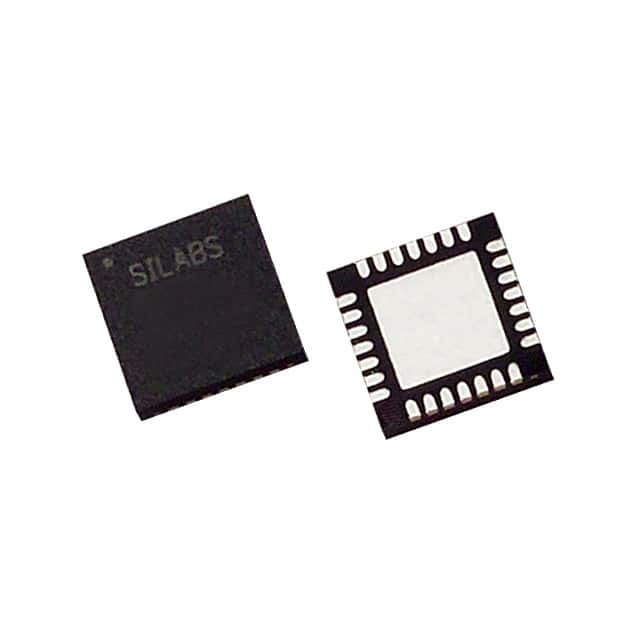CP2101
Product Overview
- Category: Integrated Circuit (IC)
- Use: USB to UART Bridge Controller
- Characteristics: Low-power, small form factor, high-performance
- Package: QFN-28
- Essence: Enables communication between a USB host and UART devices
- Packaging/Quantity: Available in tape and reel packaging, quantity varies based on supplier
Specifications
- Operating Voltage: 3.0V - 5.25V
- UART Interface: Supports full-duplex asynchronous serial communication
- USB Interface: USB 2.0 compliant, supports full-speed (12 Mbps) and low-speed (1.5 Mbps) modes
- GPIO Pins: 4 general-purpose I/O pins
- Baud Rate: Programmable from 300 bps to 2 Mbps
- Data Format: Supports 5, 6, 7, or 8 data bits, 1 or 2 stop bits, and odd/even/no parity
- Flow Control: Hardware or software flow control options available
- Operating Temperature: -40°C to +85°C
Detailed Pin Configuration
The CP2101 has a total of 28 pins arranged as follows:
- VDD - Power supply voltage
- GND - Ground
- DTR - Data Terminal Ready
- RTS - Request To Send
- TXD - Transmit Data
- RXD - Receive Data
- CTS - Clear To Send
- RI - Ring Indicator
- DCD - Data Carrier Detect
- GPIO0 - General Purpose Input/Output 0
- GPIO1 - General Purpose Input/Output 1
- GPIO2 - General Purpose Input/Output 2
- GPIO3 - General Purpose Input/Output 3
- SUSPEND - USB suspend indicator
- SUSPEND# - USB suspend control
- VBUS - USB bus voltage
- USBDM - USB data minus
- USBDP - USB data plus
- RST# - External reset input
- XTAL1 - Crystal oscillator input
- XTAL2 - Crystal oscillator output
- TEST - Test mode select
- NC - No connection
- NC - No connection
- NC - No connection
- NC - No connection
- NC - No connection
- NC - No connection
Functional Features
- Provides a bridge between USB and UART interfaces
- Supports various baud rates and data formats for flexible communication
- Low power consumption, suitable for battery-powered devices
- Small form factor enables integration into compact designs
- Built-in USB transceiver eliminates the need for external components
- Supports hardware or software flow control for reliable data transmission
Advantages and Disadvantages
Advantages: - Easy integration with USB-enabled devices - Wide operating voltage range allows compatibility with different systems - Versatile GPIO pins for additional functionality - High-performance data transfer capabilities
Disadvantages: - Limited number of GPIO pins may restrict certain applications - Requires external crystal oscillator for accurate timing
Working Principles
The CP2101 acts as a bridge between a USB host and UART devices. It converts USB data packets into UART serial data and vice versa. When connected to a USB host, it enumerates as a virtual COM port, allowing seamless communication with UART-based peripherals. The CP2101 handles all USB protocol requirements, including enumeration, error handling, and flow control.
Detailed Application Field Plans
The CP2101 finds applications in various fields, including:
- Embedded Systems: Enables USB connectivity in microcontroller-based systems
- Industrial Automation: Facilitates communication between USB-enabled devices and industrial equipment
- Internet of Things (IoT): Integrates USB connectivity in IoT devices for data transfer and control
- Consumer Electronics: Enables USB-to-UART communication in devices like smart home appliances, gaming consoles, etc.
- Medical Devices: Provides USB connectivity for data logging, firmware updates, and diagnostics
Detailed and Complete Alternative Models
- CP2102: Similar to CP2101 but with additional GPIO pins
- CP2104: Enhanced version with integrated USB transceiver and voltage regulator
- FT232R: USB to UART bridge controller from FTDI
- PL2303HX: USB to UART TTL converter from Prolific Technology
These alternative models offer similar functionality and can be considered based on specific requirements.
Word count: 520 words
قم بإدراج 10 أسئلة وإجابات شائعة تتعلق بتطبيق CP2101 في الحلول التقنية
Sure! Here are 10 common questions and answers related to the application of CP2101 in technical solutions:
Q: What is CP2101? A: CP2101 is a USB-to-UART bridge controller chip developed by Silicon Labs.
Q: What are the key features of CP2101? A: CP2101 offers a compact solution for connecting UART devices to USB-enabled systems, supporting baud rates up to 921.6 kbps.
Q: How can I interface CP2101 with my microcontroller or computer? A: CP2101 connects to your microcontroller or computer via a USB interface, providing a virtual COM port for communication.
Q: Can CP2101 be used with both Windows and macOS? A: Yes, CP2101 is compatible with both Windows and macOS operating systems, as well as Linux.
Q: What are some typical applications of CP2101? A: CP2101 is commonly used in various applications such as industrial automation, medical devices, consumer electronics, and IoT devices.
Q: Does CP2101 require any external components for operation? A: No, CP2101 is a complete USB-to-UART bridge solution and does not require any external components for basic functionality.
Q: Can CP2101 support multiple UART channels simultaneously? A: No, CP2101 is a single-channel UART bridge and supports only one UART connection at a time.
Q: Is CP2101 compatible with 3.3V and 5V logic levels? A: Yes, CP2101 supports both 3.3V and 5V logic levels, making it versatile for use with different microcontrollers and devices.
Q: Are there any software drivers required for CP2101? A: Yes, CP2101 requires software drivers to be installed on the host system. Silicon Labs provides drivers for various operating systems.
Q: Can I use CP2101 in low-power applications? A: Yes, CP2101 offers low-power modes and can be used in power-sensitive applications, helping to conserve energy.
Please note that these answers are general and may vary depending on specific implementation details and requirements.


